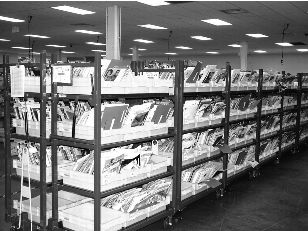Service and efficiency have gained more from the automation of mail processing than any other factor. The most important current development is the deployment of the Flats Sequencing System, which automatically sorts larger mail pieces (e.g., magazines and catalogs) in the order they are delivered. A number of other automated processing systems are also being enhanced to improve performance, add new capability, and gain new efficiency.
Year end, FSS covered 4,879 routes with 279 delivery zones, with 65 percent of flats processed for these zones in delivery point sequence.1 FSS Phase 1, to be completed in 2011, will deploy 100 systems to 47 sites. This highly complex process requires careful integration of facility modifications, site preparation, equipment relocation, process changes, staffing assignments, and training.
All major FSS preparation milestones are closely monitored to ensure successful implementation. Area and District coordinators have been established at all sites, and comprehensive hands-on training and seminars were provided to hundreds of key personnel. Online resources are also available for continuous field training and support. Maintenance training and support continues at two FSS units installed at the National Center for Employee Development in Norman, OK.

FSS can sequence flat mail at a rate of up to 16,500 pieces per hour.
Address recognition rates for flats processed on the Automated Flat Sorting Machine 100 continue to improve under Phase 2 of Flat Recognition Improvement. Hardware and software upgrades this year saved $7.3 million by increasing address read rates and reducing sortation errors.
Letter processing equipment is being upgraded to take full advantage of the IM barcode and other technology developments. In 2010, the Postal Service began to deploy the Advanced Facer Canceller System (AFCS) 200 system to replace older letter cancellation equipment. AFCS 200 significantly improves performance by reducing handling in downstream operations. Deployment of 550 systems will be completed in 2011.
Phase 2 of Distribution Quality Improvement (DQI) is improving recognition of handwritten and machine-printed addresses on letters by incorporating information from commercial databases, an enhancement that will save $30 million annually by keeping more letters in the automated mailstream. Other new software releases for automated letter systems have dramatically reduced the amount of mail rejected because of missing data or unreadable images.
In June, the Postal Service began deploying 195 Low-Cost Reject Encoding Machines, which are being built from excess carrier sequence barcode sorters. The new equipment covers unreadable barcodes with a label, interprets the mailing address, and applies the correct barcode.
Deployment of the sort accuracy improvement program for the Automated Package Processing System (APPS) was completed in November 2009. This enhancement reduces distribution errors and improves system efficiency. A laser sensor/camera was also added to APPS to quickly detect and reduce errors.
A new effort is underway to extend the service life of aging Small Parcel and Bundle Sorters (SPBS) that will still be needed at sites without APPS. Plans are to replace SPBS control systems, add barcode and optical character reader technology, and improve induction stations. The upgraded equipment will be renamed the Automated Parcel and Bundle Sorter (APBS). Successful tests of the prototype were conducted in April in Louisville, KY. Early deployment of 10 APBS is planned by November 2010, followed by deployment of production systems starting in June 2011.
The Postal Automated Redirection System (PARS) redirects forwardable letter mail during processing, a significant advance over legacy systems that required transport of such mail to a centralized forwarding system (CFS) unit. Initial PARS deployment to 283 processing facilities was completed in 2007. As PARS technology has improved, additional CFS sites have been consolidated, including 26 in 2010. The volume of mail processed each year on PARS now stands at more than 3.4 billion pieces. Fewer than 40 million pieces are currently processed through CFS units.
New PARS software permits real-time updates to national change-of-address listings. Other enhancements allow printing of new address labels at delivery units rather than at CFS sites, an improvement projected to save $2 million annually. This effort is nearly completed nationwide, with full deployment expected by December 2010.
The Postal Service deployed Integrated Data System–National Directory Support System (IDS-NDSS) hardware this year to replace existing end-of-life hardware at NDCs and processing plants. IDS provides the critical infrastructure for managing distribution operations, equipment performance, and critical maintenance within a facility. It consolidates mail and container data from all automated equipment systems and distributes it for use by multiple applications. NDSS maintains the distribution sort programs and address directory files that underlie automated mail processing.
The Mail History Tracking System (MHTS) is an application that uses barcode data to track mailpieces from origin (cancellation) to Delivery Point Sequencing processing. The application can assess if individual mailpieces are likely to meet on-time targets and helps identify and correct the root causes that lead to service failures before mail goes out for delivery. MHTS is an important tool contributing to improvements in service performance.
The Powered Industrial Vehicle Management System (PIVMS) is an analytical tool for managing powered industrial vehicles use. Work hour, equipment, and maintenance costs have been reduced significantly since deployment. There are 113 plants now using PIVMS, with annual savings of $85 million expected. System enhancements are improving reporting and performance comparisons. Additional tools in development will integrate PIVMS information with other postal data sources to further improve efficiency.
